 |
 |
|---|
-
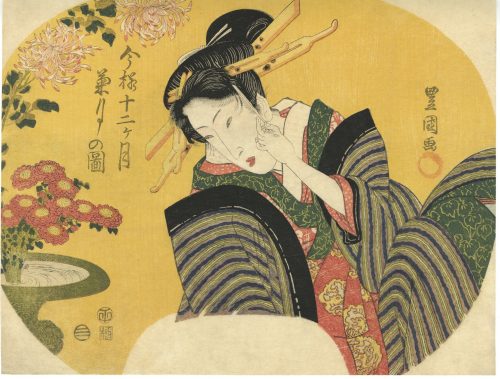 Title: Ninth lunar month [菊月] (Kikuzuki no zu); Series: Fashionable Twelve Months (Imayo juni-kagetsu). Another version of translation: Modern Beauties of Twelve Months. Artist: Utagawa Toyokuni I [歌川豊国] (1769–1825). Pubisher: Ibaya Senzaburō [伊場屋仙三郎] (Japanese, 1815 – 1869), seal: Dansendō [伊場仙]. Signed: Toyokuni ga and sealed with toshidama. Date-kiwame seal: Ushi (ox), Bunsei 5 (1822). Size: double-sheet uncut fan print ( aiban uchiwa-e), 219 x 295 mm.
Title: Ninth lunar month [菊月] (Kikuzuki no zu); Series: Fashionable Twelve Months (Imayo juni-kagetsu). Another version of translation: Modern Beauties of Twelve Months. Artist: Utagawa Toyokuni I [歌川豊国] (1769–1825). Pubisher: Ibaya Senzaburō [伊場屋仙三郎] (Japanese, 1815 – 1869), seal: Dansendō [伊場仙]. Signed: Toyokuni ga and sealed with toshidama. Date-kiwame seal: Ushi (ox), Bunsei 5 (1822). Size: double-sheet uncut fan print ( aiban uchiwa-e), 219 x 295 mm. -
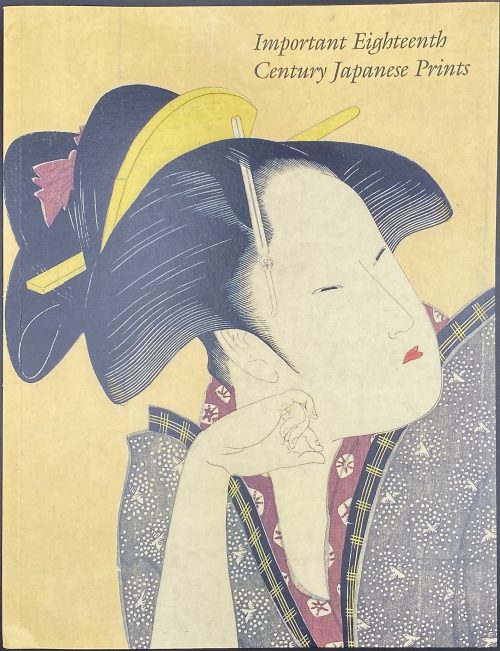 Softcover, in pictorial wrappers, 28 x 21.6 cm, 30 entries, with colour illustrations, some folding. Catalogue of the sales exhibition on November 1-5, 2019 in NY; pagination: [1-3] 4-72 [2] [2 blank], ils. Contributor: Sebastian Izzard
Softcover, in pictorial wrappers, 28 x 21.6 cm, 30 entries, with colour illustrations, some folding. Catalogue of the sales exhibition on November 1-5, 2019 in NY; pagination: [1-3] 4-72 [2] [2 blank], ils. Contributor: Sebastian Izzard -
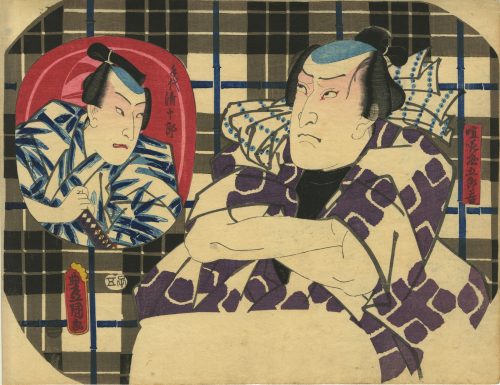 Artist: Utagawa Kunisada [歌川 国貞] a.k.a. Utagawa Toyokuni III [三代歌川豊国] (Japanese, 1786 – 1865). Publisher: Ibaya Senzaburō [伊場屋仙三郎] (Japanese, fl. C. 1845 – 1847). Date seal: [子五] Kaei 5, 5th month (5/1852). Signed: Toyokuni ga [豊国 画] in a red toshidama cartouche. Title: Actor Bandō Takesaburō I as clerk Seijūrō [手代清十郎] (left) and Actor Ichikawa Kodanji IV as Kenkaya Gorōkichi [喧嘩屋五郎吉] (right) in the play Musume ōgi tsui no tatehiki [娘扇一対侠贔屓 (むすめおうぎついのたてひき)] performed at the Nakamura theatre [中村座], in Edo (Tokyo). The playbill for this performance can be found at MFA (Boston) # 11.28042, 11.28285, 11.28286:
Artist: Utagawa Kunisada [歌川 国貞] a.k.a. Utagawa Toyokuni III [三代歌川豊国] (Japanese, 1786 – 1865). Publisher: Ibaya Senzaburō [伊場屋仙三郎] (Japanese, fl. C. 1845 – 1847). Date seal: [子五] Kaei 5, 5th month (5/1852). Signed: Toyokuni ga [豊国 画] in a red toshidama cartouche. Title: Actor Bandō Takesaburō I as clerk Seijūrō [手代清十郎] (left) and Actor Ichikawa Kodanji IV as Kenkaya Gorōkichi [喧嘩屋五郎吉] (right) in the play Musume ōgi tsui no tatehiki [娘扇一対侠贔屓 (むすめおうぎついのたてひき)] performed at the Nakamura theatre [中村座], in Edo (Tokyo). The playbill for this performance can be found at MFA (Boston) # 11.28042, 11.28285, 11.28286: Actors:
Bandō Takesaburō I (初代坂東竹三郎) (Japanese, 1832 – 1877); other names: Shinshi, Shinsui V, Bandō Hikosaburō V [五代目坂東彦三郎], Bandō Tsurunosuke I.
Ichikawa Kodanji IV [市川小團次] (Japanese, 1812 – 1866); other names: Ichikawa Yonejūrō I, Ichikawa Yonezō III, Ichikawa Eizō.
Actors:
Bandō Takesaburō I (初代坂東竹三郎) (Japanese, 1832 – 1877); other names: Shinshi, Shinsui V, Bandō Hikosaburō V [五代目坂東彦三郎], Bandō Tsurunosuke I.
Ichikawa Kodanji IV [市川小團次] (Japanese, 1812 – 1866); other names: Ichikawa Yonejūrō I, Ichikawa Yonezō III, Ichikawa Eizō.
Similar images were then used for the series Seven flourishing plants on lanterns for summer evenings [涼調珍盛の七草] (Suzumi chōchin sakari no nanakusa) published by Ibaya Senzaburō in 1852 (Kaei 5), 6th month.

Bandō Takesaburō I (carved by Yokokawa Takejirō): https://collections.mfa.org/objects/219360

Actor Ichikawa Kodanji IV (carved by Nakamura Tōkichi): https://collections.mfa.org/objects/477146.
-
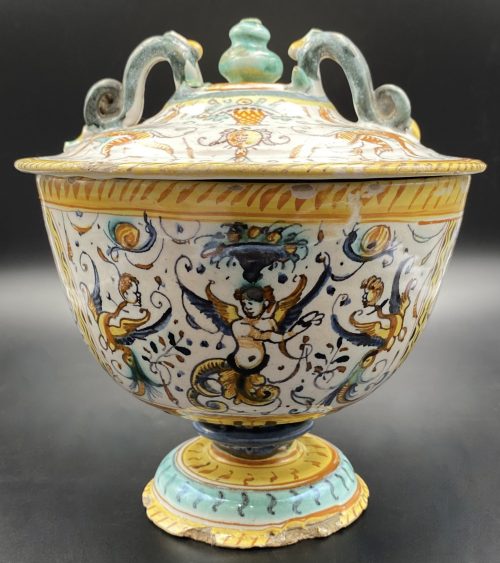 Tin-glazed earthenware footed lidded cup decorated with winged creatures and grotesque paintings, Bachus and Cupid inside. Minor losses Diameter: 16 cm; Height: 18 cm. Attributed to Deruta, Italy, c. 1600.
Tin-glazed earthenware footed lidded cup decorated with winged creatures and grotesque paintings, Bachus and Cupid inside. Minor losses Diameter: 16 cm; Height: 18 cm. Attributed to Deruta, Italy, c. 1600. -
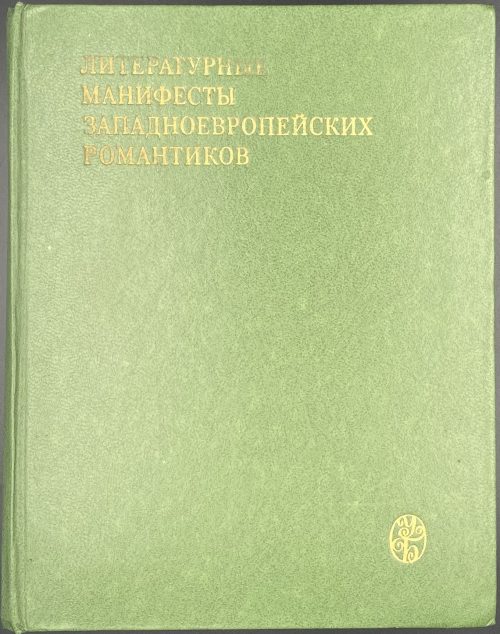 Description: Hardcover, 22.2 x 17.2 cm, in green buckram with gilt lettering to front cover and spine, pp.: [1-4] 5-638 [2], 640 pages total. Incl.: Ф.-Р. де Шатобриан. Из «гения христианства». Title-page: ЛИТЕРАТУРНЫЕ | МАНИФЕСТЫ | ЗАПАДНОЕВРОПЕЙСКИХ | РОМАНТИКОВ | Собрание текстов, | вступительная статья и общая редакция | проф. А. С. Дмитриева | Издательство Московского университета | 1980 || Contributors: Дмитриев, Александр Сергеевич (Russian, 1919 – 2001) François-René de Chateaubriand (French, 1768 – 1848)
Description: Hardcover, 22.2 x 17.2 cm, in green buckram with gilt lettering to front cover and spine, pp.: [1-4] 5-638 [2], 640 pages total. Incl.: Ф.-Р. де Шатобриан. Из «гения христианства». Title-page: ЛИТЕРАТУРНЫЕ | МАНИФЕСТЫ | ЗАПАДНОЕВРОПЕЙСКИХ | РОМАНТИКОВ | Собрание текстов, | вступительная статья и общая редакция | проф. А. С. Дмитриева | Издательство Московского университета | 1980 || Contributors: Дмитриев, Александр Сергеевич (Russian, 1919 – 2001) François-René de Chateaubriand (French, 1768 – 1848) -
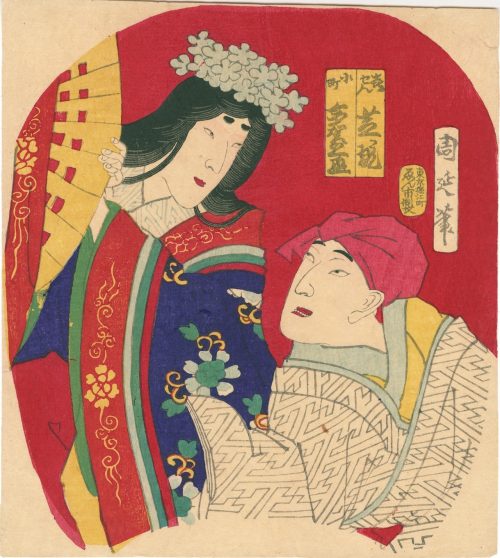 Artist: Toyohara Chikanobu [豊原周延] (Japanese, 1838 – 1912) Signed: Chikanobu hitsu [周延筆] Publisher: [ 東京掘江町] Tokyo Horiemachi | [えん市製] Enshi-sei. Media: Fan print (uchiwa-e, 団扇絵), 192 x 172 mm. Possibly Iwai Kumesaburō IV [岩井粂三郎] (1856 – 1886) a.k.a. Iwai Hisajirō III [岩井久次郎] in the role of Ono no Komachi [小野乃小町] and Nakamura Shikan IV [中村芝翫] in the role of Kisen Hōshi [喜せん法師]. Play: The Six Immortal Poets in Colorful Guises [六歌仙体綵] (Rokkasen Sugata no irodori). Inscription: Left: Kisen [喜せん] | Shikan [芝翫] Right: Komachi [小町] | Kumesaburō [粂三郎]. Actors: Iwai Kumesaburō IV [岩井粂三郎] (1856 – 1886) a.k.a. Iwai Hisajirō III [岩井久次郎]. Nakamura Shikan IV [中村芝翫] (Japanese, 1831 – 1899); other names: Nakamura Fukusuke I [中村福助], Nakamura Masanosuke I, Nakamura Komasaburō, Nakamura Tamatarō I.
Artist: Toyohara Chikanobu [豊原周延] (Japanese, 1838 – 1912) Signed: Chikanobu hitsu [周延筆] Publisher: [ 東京掘江町] Tokyo Horiemachi | [えん市製] Enshi-sei. Media: Fan print (uchiwa-e, 団扇絵), 192 x 172 mm. Possibly Iwai Kumesaburō IV [岩井粂三郎] (1856 – 1886) a.k.a. Iwai Hisajirō III [岩井久次郎] in the role of Ono no Komachi [小野乃小町] and Nakamura Shikan IV [中村芝翫] in the role of Kisen Hōshi [喜せん法師]. Play: The Six Immortal Poets in Colorful Guises [六歌仙体綵] (Rokkasen Sugata no irodori). Inscription: Left: Kisen [喜せん] | Shikan [芝翫] Right: Komachi [小町] | Kumesaburō [粂三郎]. Actors: Iwai Kumesaburō IV [岩井粂三郎] (1856 – 1886) a.k.a. Iwai Hisajirō III [岩井久次郎]. Nakamura Shikan IV [中村芝翫] (Japanese, 1831 – 1899); other names: Nakamura Fukusuke I [中村福助], Nakamura Masanosuke I, Nakamura Komasaburō, Nakamura Tamatarō I. -
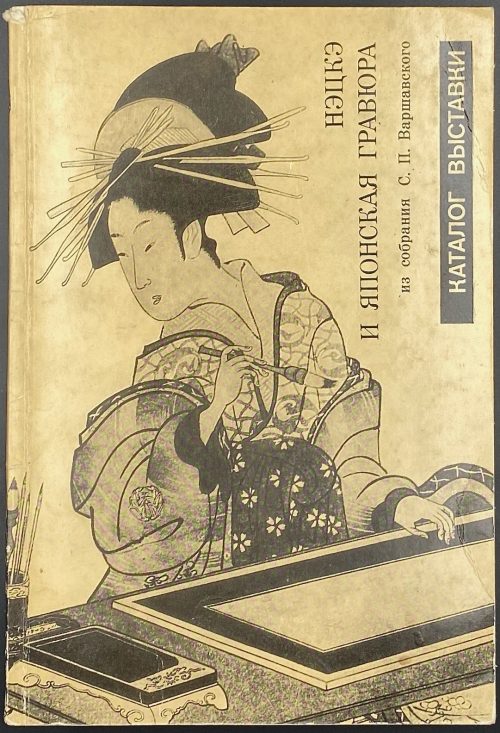 Mikhail Uspensky, Elena Varshavskaya. The netsuke and Japanese woodblock prints from the collection of S. P. Varshavsky. Printed by demand of The Hermitage Museum. Title-page (vertical bottom to top): ГОСУДАРСТВЕННЫЙ ОРДЕНА ЛЕНИНА | ЭРМИТАЖ | НЭЦКЭ | И ЯПОНСКАЯ | ГРАВЮРА | из собрания | С. П. Варшавского | КАТАЛОГ ВЫСТАВКИ | — | ЛЕНИНГРАД | “ИСКУССТВО” | ЛЕНИНГРАДСКОЕ ОТДЕЛЕНИЕ | 1983 | {vignette} || Description: Softcover, pictorial wrappers, 21.5 x 14.5 cm, pp.: [1-8] 9-42 [43-51] (b/w plates unpag.) [52] 53-76 [77-95] (b/w plates unpag.) [96] (colophon); total 96 pages plus four leaves of colour plates. Catalogue:137 entries of netsuke, 69 entries of Japanese woodblock prints. Print run: 3,000 copies. Contributors: Mikhail Uspensky [Михаил Владимирович Успенский] (Russian, 1953 – 1997) Elena Varshavsky [Елена Юрьевна Варшавская (Jewish-American, b. 1952) Vladislav Sisauri [Владислав Ираклиевич Сисаури] (Russian, b. 1944) Sergei Petrovich Varshavsky [Сергей Петрович Варшавский] (Jewish-Russian, 1906 – 1980).
Mikhail Uspensky, Elena Varshavskaya. The netsuke and Japanese woodblock prints from the collection of S. P. Varshavsky. Printed by demand of The Hermitage Museum. Title-page (vertical bottom to top): ГОСУДАРСТВЕННЫЙ ОРДЕНА ЛЕНИНА | ЭРМИТАЖ | НЭЦКЭ | И ЯПОНСКАЯ | ГРАВЮРА | из собрания | С. П. Варшавского | КАТАЛОГ ВЫСТАВКИ | — | ЛЕНИНГРАД | “ИСКУССТВО” | ЛЕНИНГРАДСКОЕ ОТДЕЛЕНИЕ | 1983 | {vignette} || Description: Softcover, pictorial wrappers, 21.5 x 14.5 cm, pp.: [1-8] 9-42 [43-51] (b/w plates unpag.) [52] 53-76 [77-95] (b/w plates unpag.) [96] (colophon); total 96 pages plus four leaves of colour plates. Catalogue:137 entries of netsuke, 69 entries of Japanese woodblock prints. Print run: 3,000 copies. Contributors: Mikhail Uspensky [Михаил Владимирович Успенский] (Russian, 1953 – 1997) Elena Varshavsky [Елена Юрьевна Варшавская (Jewish-American, b. 1952) Vladislav Sisauri [Владислав Ираклиевич Сисаури] (Russian, b. 1944) Sergei Petrovich Varshavsky [Сергей Петрович Варшавский] (Jewish-Russian, 1906 – 1980). -
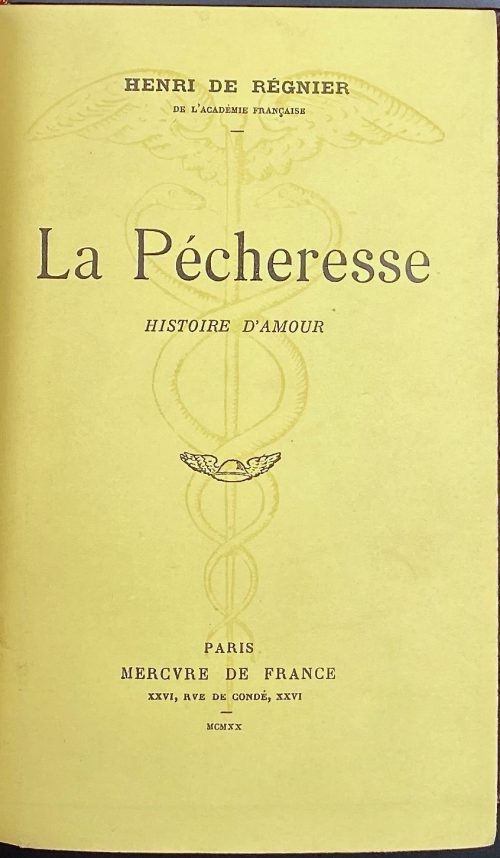 Hardcover volume, 19 x 13 cm, collated in-12mo, bound by Henri Creuzevault (signed) in full crushed brown morocco, spine with raised bands, gilt lettering “H. DE RÉGNIER | – | LA PÉCHERESSE” and “PARIS 1920” in the bottom compartment; gilt fillet to cover margin, five gilt fillets inside, marbled endpapers, bookplate of J.-P. Dutel to flyleaf, original yellow publisher’s wrappers preserved, top edge gilt, in a marbled slipcase; printed on dense wove paper (Japon). Inset: Receipt from Librairie ancienne et modern – Georges Venot (Lyon), dated April 16, 1938. Title-page / Cover: HENRI DE RÉGNIER | DE L’ACADÉMIE FRANÇAISE | – | La Pécheresse | HISTOIRE D’AMOUR | {publisher’s device} | PARIS | MERCVRE DE France | XXVI, RVE DE CONDÉ, XXVI | MCMXX || Limitation: 158 copies on Japon (№№ 1-158), 95 copies on Chine (№№ 159-253), 515 copies on Hollande (№№ 254-768), 1,650 copies on vélin pur fil de Lafuma (№№ 769-2393, and 25 copies not for sale marked A-Z. This is № 75 (on Japon), a unique copy enriched with 7 original watercolours by Serge de Solomko. Collation: 3 blank flyleaves, front wrapper, π6 (1 h.t./advert., 1 t.p./limit., 1 dedication, 3), 1-206, 212, back wrapper, spine, 3 blank flyleaves, list of illustrations pasted to recto endpaper “La Pécheresse. | 7 aquarelles de Solemko (sic.) | 57, 64, 168, 256, 289, 320, 346”, seven plates bound in as per the list. Pagination: [1-5] 6-350, ils. OCLC Number / Unique Identifier: 715077259. Contributors: Henri de Régnier (French, 1864 – 1936) – author. Auguste Gilbert de Voisins (1877 – 1939) – dedicatee. Sergueï Solomko [Сергей Сергеевич Соломко, Serge de Solomko] (Russian-French, 1867 – 1928) – artist. Henri Creuzevault (French, 1905 – 1971) – bookbinder. J.-P. Dutel description: RÉGNIER, Henri de. LA PECHERESSE. Paris, Mercure de France, 1920. In-12 (18,3 x 11,4 cm) de [1] f., 350 pp., maroquin janséniste grenat, dos à 5 nerfs, filets dorés intérieurs, tête dorée, filets dorés sur les coupes, non rogné, couverture et dos conservés, étui bordé. (Creuzevault). ÉDITION ORIGINALE. Tirage : 95 ex. sur chine. 158 ex. sur japon. 515 ex. sur hollande. UN DES 158 EXEMPLAIRES SUR JAPON. EXEMPLAIRE UNIQUE ENRICHI DE 7 AQUARELLES ORIGINALES HORS-TEXTE SIGNÉES PAR SERGE DE SOLOMKO. Sergueï Sergueïevitch Solomko « Serge de Solomko », (Saint-Petersburg, 1867- Sainte Geneviève des bois, 1928) est un illustrateur, graphiste et aquarelliste russe qui vécut en partie en France. Qualifiée d'histoire d'amour, cette œuvre d'Henri de Régnier est dédiée à Gilbert de Voisins, poète et romancier, en témoignage de fraternelle amitié. Elle est placée par son auteur sous les auspices du moraliste et critique libertin Saint-Evremond dont une citation figure en exergue du livre : « Il y a des temps où l'on pleure les plaisirs perdus, des temps où l'on pleure les péchés commis. » Et l'auteur d'incipiter comme suit : « J'ai toujours été si curieux des particularités que l'on découvre au caractère des femmes que, pas une fois, je n'ai négligé de m'instruire sur le sujet. » « (...) le point où se montre le mieux et le plus ouvertement ce que la nature les a faites, est celui de l'amour. »
Hardcover volume, 19 x 13 cm, collated in-12mo, bound by Henri Creuzevault (signed) in full crushed brown morocco, spine with raised bands, gilt lettering “H. DE RÉGNIER | – | LA PÉCHERESSE” and “PARIS 1920” in the bottom compartment; gilt fillet to cover margin, five gilt fillets inside, marbled endpapers, bookplate of J.-P. Dutel to flyleaf, original yellow publisher’s wrappers preserved, top edge gilt, in a marbled slipcase; printed on dense wove paper (Japon). Inset: Receipt from Librairie ancienne et modern – Georges Venot (Lyon), dated April 16, 1938. Title-page / Cover: HENRI DE RÉGNIER | DE L’ACADÉMIE FRANÇAISE | – | La Pécheresse | HISTOIRE D’AMOUR | {publisher’s device} | PARIS | MERCVRE DE France | XXVI, RVE DE CONDÉ, XXVI | MCMXX || Limitation: 158 copies on Japon (№№ 1-158), 95 copies on Chine (№№ 159-253), 515 copies on Hollande (№№ 254-768), 1,650 copies on vélin pur fil de Lafuma (№№ 769-2393, and 25 copies not for sale marked A-Z. This is № 75 (on Japon), a unique copy enriched with 7 original watercolours by Serge de Solomko. Collation: 3 blank flyleaves, front wrapper, π6 (1 h.t./advert., 1 t.p./limit., 1 dedication, 3), 1-206, 212, back wrapper, spine, 3 blank flyleaves, list of illustrations pasted to recto endpaper “La Pécheresse. | 7 aquarelles de Solemko (sic.) | 57, 64, 168, 256, 289, 320, 346”, seven plates bound in as per the list. Pagination: [1-5] 6-350, ils. OCLC Number / Unique Identifier: 715077259. Contributors: Henri de Régnier (French, 1864 – 1936) – author. Auguste Gilbert de Voisins (1877 – 1939) – dedicatee. Sergueï Solomko [Сергей Сергеевич Соломко, Serge de Solomko] (Russian-French, 1867 – 1928) – artist. Henri Creuzevault (French, 1905 – 1971) – bookbinder. J.-P. Dutel description: RÉGNIER, Henri de. LA PECHERESSE. Paris, Mercure de France, 1920. In-12 (18,3 x 11,4 cm) de [1] f., 350 pp., maroquin janséniste grenat, dos à 5 nerfs, filets dorés intérieurs, tête dorée, filets dorés sur les coupes, non rogné, couverture et dos conservés, étui bordé. (Creuzevault). ÉDITION ORIGINALE. Tirage : 95 ex. sur chine. 158 ex. sur japon. 515 ex. sur hollande. UN DES 158 EXEMPLAIRES SUR JAPON. EXEMPLAIRE UNIQUE ENRICHI DE 7 AQUARELLES ORIGINALES HORS-TEXTE SIGNÉES PAR SERGE DE SOLOMKO. Sergueï Sergueïevitch Solomko « Serge de Solomko », (Saint-Petersburg, 1867- Sainte Geneviève des bois, 1928) est un illustrateur, graphiste et aquarelliste russe qui vécut en partie en France. Qualifiée d'histoire d'amour, cette œuvre d'Henri de Régnier est dédiée à Gilbert de Voisins, poète et romancier, en témoignage de fraternelle amitié. Elle est placée par son auteur sous les auspices du moraliste et critique libertin Saint-Evremond dont une citation figure en exergue du livre : « Il y a des temps où l'on pleure les plaisirs perdus, des temps où l'on pleure les péchés commis. » Et l'auteur d'incipiter comme suit : « J'ai toujours été si curieux des particularités que l'on découvre au caractère des femmes que, pas une fois, je n'ai négligé de m'instruire sur le sujet. » « (...) le point où se montre le mieux et le plus ouvertement ce que la nature les a faites, est celui de l'amour. » -
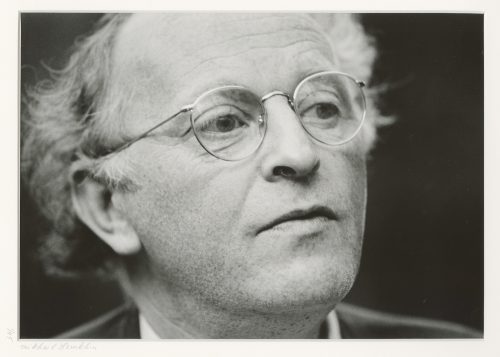 Photographic portrait of poet Joseph Brodsky, head and shoulders, three-quarters to the right, wearing glasses. Pencil-signed on the mat: 1/45 • Mikhail Lemkhin; same inscription on the back of the print, and ink stamp ©Mikhail Lemkhin. Sitter: Joseph Brodsky [Иосиф Александрович Бродский ] (Russian-American-Jewish, 1940 – 1996). Size: mat: 40.5 x 51 cm; window: 24.5 x 35 cm; print: 27.7 x 35.4 cm.
Photographic portrait of poet Joseph Brodsky, head and shoulders, three-quarters to the right, wearing glasses. Pencil-signed on the mat: 1/45 • Mikhail Lemkhin; same inscription on the back of the print, and ink stamp ©Mikhail Lemkhin. Sitter: Joseph Brodsky [Иосиф Александрович Бродский ] (Russian-American-Jewish, 1940 – 1996). Size: mat: 40.5 x 51 cm; window: 24.5 x 35 cm; print: 27.7 x 35.4 cm. -
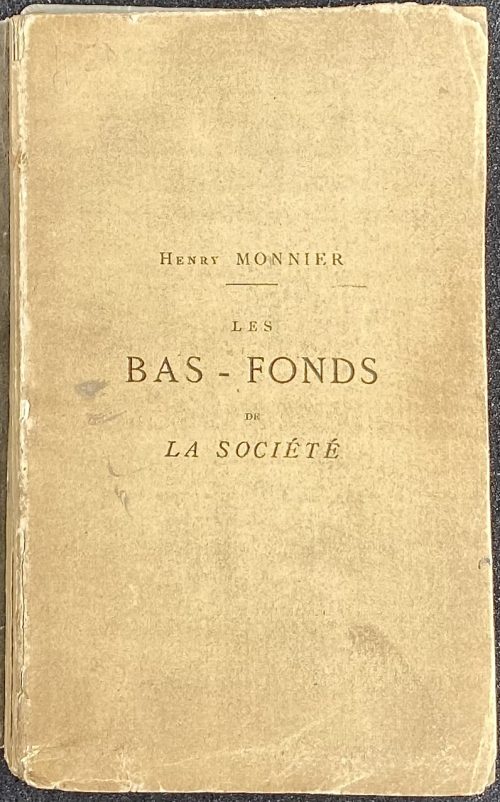 Small softcover volume, ‘édition minuscule’ in-32, 13 x 8 cm, publisher’s wrappers, pp.: [1-6] (h.t., t.p., advert.), [7] 8-160 [2 table/blank], included in pagination 8 pasted etchings on India paper after Félicien Rops and one blank leaf next to plate 1; laid paper with watermarks, some pages uncut. Title-page: DOCUMENTS | POUR SERVIR A L’HISTOIRE DE NOS MŒURS | – | LES | BAS-FONDS | DE LA SOCIÉTÉ | PAR | HENRY MONNIER | AVEC | 8 dessins à la plume | de F. R. | {fleuron} | ÉDITION MINUSCULE | tirée | à 64 exemplaires. || Pencil handwriting on top: 8 gravures de Felicien Rops | 250 –, in the bottom: [1879]. Print run: 64 copies; clandestine edition. Catalogue raisonné: Vicaire V, 1019; Bory p. 100 (though here is the frontispiece for Les Bas-fonds de la société par Joseph Prudhomme [Henry Monnier], 1864, with all the sheets together; Dutel I, A-134. Ref: (1) Poulet-Malassis & ses amis № 90 [LIB-3118.2022] ; (2) Félicien Rops: L'oeuvre graphique complète. / Ouvrage établi et présenté par Jean-François Bory. Avec un texte contemporain de l'artiste par J. K. Huysmans. — Arthur Hubschmidt, 1977. [LIB-2241.2019] Contributors: Henry Monnier (French, 1799 – 1877) – author. Félicien Rops (Belgian, 1833 – 1898) – artist. Henry Kistemaeckers (Belgian, 1851 – 1934) – publisher. Auguste Poulet-Malassis (French, 1825 – 1878)
Small softcover volume, ‘édition minuscule’ in-32, 13 x 8 cm, publisher’s wrappers, pp.: [1-6] (h.t., t.p., advert.), [7] 8-160 [2 table/blank], included in pagination 8 pasted etchings on India paper after Félicien Rops and one blank leaf next to plate 1; laid paper with watermarks, some pages uncut. Title-page: DOCUMENTS | POUR SERVIR A L’HISTOIRE DE NOS MŒURS | – | LES | BAS-FONDS | DE LA SOCIÉTÉ | PAR | HENRY MONNIER | AVEC | 8 dessins à la plume | de F. R. | {fleuron} | ÉDITION MINUSCULE | tirée | à 64 exemplaires. || Pencil handwriting on top: 8 gravures de Felicien Rops | 250 –, in the bottom: [1879]. Print run: 64 copies; clandestine edition. Catalogue raisonné: Vicaire V, 1019; Bory p. 100 (though here is the frontispiece for Les Bas-fonds de la société par Joseph Prudhomme [Henry Monnier], 1864, with all the sheets together; Dutel I, A-134. Ref: (1) Poulet-Malassis & ses amis № 90 [LIB-3118.2022] ; (2) Félicien Rops: L'oeuvre graphique complète. / Ouvrage établi et présenté par Jean-François Bory. Avec un texte contemporain de l'artiste par J. K. Huysmans. — Arthur Hubschmidt, 1977. [LIB-2241.2019] Contributors: Henry Monnier (French, 1799 – 1877) – author. Félicien Rops (Belgian, 1833 – 1898) – artist. Henry Kistemaeckers (Belgian, 1851 – 1934) – publisher. Auguste Poulet-Malassis (French, 1825 – 1878) -
 Artist: Utagawa Kuniyoshi [歌川 國芳] (1798 – 1861). Kabuki actors Ichikawa Danjūrō VIII and Arashi Rikan III as sumo wrestlers Nuregami Chōgorō (L) and Hanaregoma Chōkichi (R), respectively. Signed: Ichiyûsai Kuniyoshi ga (一勇斎 國芳 画) in a double gourd-shaped cartouche with Yoshi Kiri seal. Publisher: No seal. Date seal and double nanushi censor seal: Mera & Watanabe, 1852. Media: Fan print (uchiwa-e, 団扇絵), 231 x 295 mm. Theme: Nine-act drama (11 scenes) Futatsu Chōchō Kuruwa Nikki [双蝶々曲輪日記] (A Diary of Two Butterflies in the Pleasure Quarters) written by Takeda Izumo II, Namiki Senryū I, Miyoshi Shōraku (7/1749) as puppet play Bunraku [文楽], adopted for Kabuki theatre by Arashi San'emon IV. “The sumo wrestler Nuregami Chōgorō is trying to ransom the courtesan Azuma for Yogoro, in whose debt he stands. Hiraoka Goemon, who is at odds with Yogorō and Azuma, is the patron of the amateur wrestler Hanaregoma Chōkichi. Chōgorō purposely loses to Chōkichi and then asks the latter to stop Goemon's ransoming of Azuma; Chōkichi refuses, however, and they quarrel. Admonished for his dissipation by his sister Oseki, Chōkichi is going to commit ritual suicide (seppuku) as an apology for his behavior, but Chōgorō, who happens along just then, prevents him. The two men swear blood brotherhood. […] The confrontation between Chōgorō and Chōkichi in the Sumōba scene, acted in the exaggerated style called aragoto, is a major highlight of the work. The scene in Yohei's home, known as Hikimado, presents the unfolding of Kabuki's eternal conflict between duty and feelings, here represented by the act of opening the skylight (hikimado) to which Chōgorō is tied”. [Samuel L. Leiter. Kabuki Encyclopedia: an English-language adaptation of Kabuki Jiten. — Westport, CT; London: Greenwood Press, 1979, pp. 70-71]. See also James R. Brandon and Samuel L. Leiter. Kabuki plays on stage, vol. 1, pp. 234-258. — Honolulu: University of Hawai'i Press, 2002. Actors: Ichikawa Danjūrō VIII [市川団十郎] (Japanese, 1823 – 1854); other names: Ichikawa Ebizō VI, Ichikawa Shinnosuke II. Arashi Rikan III [嵐璃寛] (Japanese, 1812 – 1863); other names Arashi Tokusaburō III, Arashi Kicchō I, Onoe Wasaburō I. Another print in this collection with the same theme: SVJP-0331.2020.
Artist: Utagawa Kuniyoshi [歌川 國芳] (1798 – 1861). Kabuki actors Ichikawa Danjūrō VIII and Arashi Rikan III as sumo wrestlers Nuregami Chōgorō (L) and Hanaregoma Chōkichi (R), respectively. Signed: Ichiyûsai Kuniyoshi ga (一勇斎 國芳 画) in a double gourd-shaped cartouche with Yoshi Kiri seal. Publisher: No seal. Date seal and double nanushi censor seal: Mera & Watanabe, 1852. Media: Fan print (uchiwa-e, 団扇絵), 231 x 295 mm. Theme: Nine-act drama (11 scenes) Futatsu Chōchō Kuruwa Nikki [双蝶々曲輪日記] (A Diary of Two Butterflies in the Pleasure Quarters) written by Takeda Izumo II, Namiki Senryū I, Miyoshi Shōraku (7/1749) as puppet play Bunraku [文楽], adopted for Kabuki theatre by Arashi San'emon IV. “The sumo wrestler Nuregami Chōgorō is trying to ransom the courtesan Azuma for Yogoro, in whose debt he stands. Hiraoka Goemon, who is at odds with Yogorō and Azuma, is the patron of the amateur wrestler Hanaregoma Chōkichi. Chōgorō purposely loses to Chōkichi and then asks the latter to stop Goemon's ransoming of Azuma; Chōkichi refuses, however, and they quarrel. Admonished for his dissipation by his sister Oseki, Chōkichi is going to commit ritual suicide (seppuku) as an apology for his behavior, but Chōgorō, who happens along just then, prevents him. The two men swear blood brotherhood. […] The confrontation between Chōgorō and Chōkichi in the Sumōba scene, acted in the exaggerated style called aragoto, is a major highlight of the work. The scene in Yohei's home, known as Hikimado, presents the unfolding of Kabuki's eternal conflict between duty and feelings, here represented by the act of opening the skylight (hikimado) to which Chōgorō is tied”. [Samuel L. Leiter. Kabuki Encyclopedia: an English-language adaptation of Kabuki Jiten. — Westport, CT; London: Greenwood Press, 1979, pp. 70-71]. See also James R. Brandon and Samuel L. Leiter. Kabuki plays on stage, vol. 1, pp. 234-258. — Honolulu: University of Hawai'i Press, 2002. Actors: Ichikawa Danjūrō VIII [市川団十郎] (Japanese, 1823 – 1854); other names: Ichikawa Ebizō VI, Ichikawa Shinnosuke II. Arashi Rikan III [嵐璃寛] (Japanese, 1812 – 1863); other names Arashi Tokusaburō III, Arashi Kicchō I, Onoe Wasaburō I. Another print in this collection with the same theme: SVJP-0331.2020. Reference images:
Reference images:
-
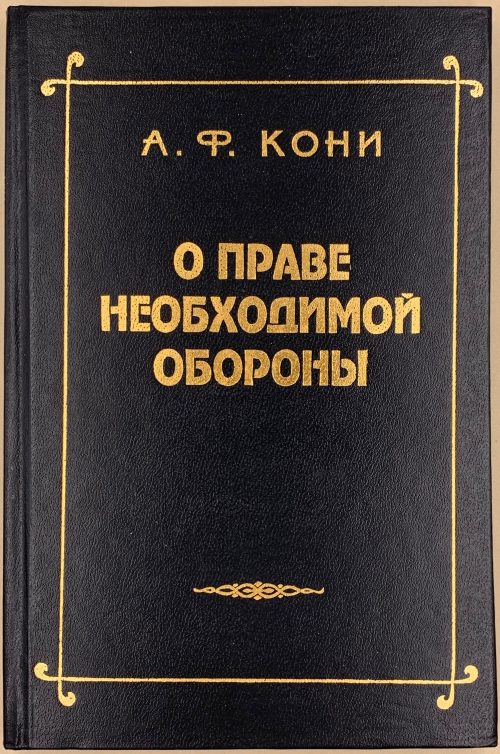 Hardcover volume, 20.8 x 13.8 cm, bound in black buckram with gilt lettering to front cover and spine; pp.: [2] 3-112. Portrait of young Anatoly Koni to fep verso. Print run: 5,000 copies. About the right of the defence of necessity – a reprint of the first work of distinguished Russian jurist Anatoly Koni, originally published in «Приложение к Университетским известиям» in 1865 and Кони А. О правѣ необходимой обороны. Рассужденiе. - М.: В Университетской Типографiи, 1866.
Hardcover volume, 20.8 x 13.8 cm, bound in black buckram with gilt lettering to front cover and spine; pp.: [2] 3-112. Portrait of young Anatoly Koni to fep verso. Print run: 5,000 copies. About the right of the defence of necessity – a reprint of the first work of distinguished Russian jurist Anatoly Koni, originally published in «Приложение к Университетским известиям» in 1865 and Кони А. О правѣ необходимой обороны. Рассужденiе. - М.: В Университетской Типографiи, 1866. -
 Iron tsuba of round form decorated with eight roundels – circular emblems of flowers and/or family crests (mon) made of cast brass, pierced and chiselled in kebori, and with flat brass inlay (hira-zōgan) of vines or leaves all over the plate. Both hitsu-ana are trimmed with brass. Nakago-ana of trapezoidal form. A distinctive character of this tsuba is a mon at 12 hours, depicting paulownia, or Kiri-mon [桐紋] – a symbol of the Toyotomi clan, led by Toyotomi Hideyoshi (豊臣 秀吉, 1537 – 1598). Kiri-mon was also used as fuku-mon (alternative family crests) for the Imperial Family and Imperial Court. Another important emblem at 6 o’clock is the Katakura clan [片倉氏, Katakura-shi] family crest. Katakura Kagetsuna (片倉 景綱, 1557 – 1615), a retainer of Date Masamune (伊達 政宗, 1567 – 1636); Kagetsuna was operational in Hideyoshi’s Odawara campaign in 1590, which ultimately ended the unification of Japan. Unsigned but may be attributed to Koike Yoshirō Naomasa or his workshop (Yoshirō, orKaga-Yoshirō school). Dimensions: Diameter: 85.5 mm; Thickness at seppa-dai: 5.0 mm.
Iron tsuba of round form decorated with eight roundels – circular emblems of flowers and/or family crests (mon) made of cast brass, pierced and chiselled in kebori, and with flat brass inlay (hira-zōgan) of vines or leaves all over the plate. Both hitsu-ana are trimmed with brass. Nakago-ana of trapezoidal form. A distinctive character of this tsuba is a mon at 12 hours, depicting paulownia, or Kiri-mon [桐紋] – a symbol of the Toyotomi clan, led by Toyotomi Hideyoshi (豊臣 秀吉, 1537 – 1598). Kiri-mon was also used as fuku-mon (alternative family crests) for the Imperial Family and Imperial Court. Another important emblem at 6 o’clock is the Katakura clan [片倉氏, Katakura-shi] family crest. Katakura Kagetsuna (片倉 景綱, 1557 – 1615), a retainer of Date Masamune (伊達 政宗, 1567 – 1636); Kagetsuna was operational in Hideyoshi’s Odawara campaign in 1590, which ultimately ended the unification of Japan. Unsigned but may be attributed to Koike Yoshirō Naomasa or his workshop (Yoshirō, orKaga-Yoshirō school). Dimensions: Diameter: 85.5 mm; Thickness at seppa-dai: 5.0 mm.
Kiri-mon

Katakura-mon
-
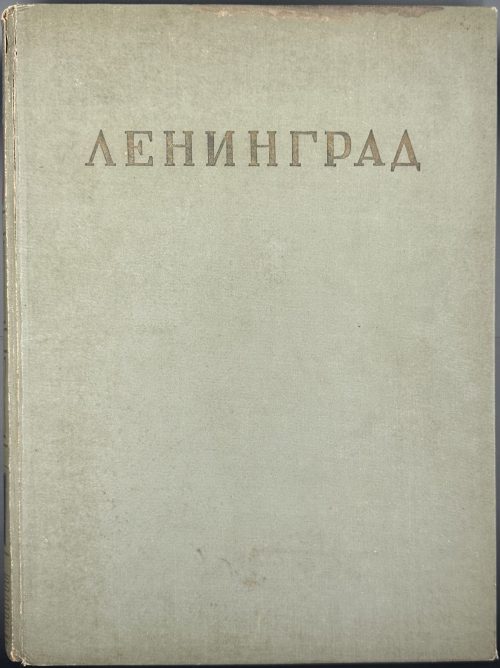 Hardcover volume 36 x 27.5 cm, bound in grey cloth, gilt lettering ЛЕНИНГРАД to front board, red and black labels with gilt lettering, gilt compartments to flat spine, red endpapers with black and white border, pp.: [1-6] 7-402 [2], total 202 leaves with numerous b/w illustrations, plus frontispiece with pasted in b/w plate. Bookplate of Feodor Rojankovsky to front pastedown, ms inscription: “Дорогой Федя, дарю Вам на Ваше рождение эту книгу” signed “Ф. Рожанковский” Half-title (red on tan): ИЗДАНО В ЛЕНИНГРАДЕ | В ДНИ ВЕЛИКОЙ | ОТЕЧЕСТВЕННОЙ ВОЙНЫ || Half-title verso (red on tan): ЛЕНИНГРАДСКИЙ ГОРОДСКОЙ СОВЕТ | ДЕПУТАТОВ ТРУДЯЩИХСЯ | ИСПОЛНИТЕЛЬНЫЙ КОМИТЕТ | {vignette «plan»} | АРХИТЕКТУРНО-ПЛАНИРОВОЧНОЕ | УПРАВЛЕНИЕ | 1943 || Title-page (red on tan) ЛЕНИНГРАД | {vignette «Admiralty»} | ГОСУДАРСТВЕННОЕ ИЗДАТЕЛЬСТВО | «ИСКУССТВО» | ЛЕНИНГРАД – 1943 – МОСКВА || Blue ink stamp to bottom right: Printed in Soviet Union. Title-page verso: РЕДАКЦИОННАЯ | КОЛЛЕГИЯ | Ответственный редактор | БАРАНОВ Н. В. | КАМЕНСКИЙ В. А. | МОРОЗОВ М. В. | РУБАНЕНКО Б. Р. | ФОМИН И. И. | Художник издания | КАМЕНСКИЙ В. А. | Технический редактор | АНИСИМОВ М. Н. Contents (red on tan): АРХИТЕКТУРНО-ПЛАНИРОВОЧНЫЙ | ОБЗОР РАЗВИТИЯ ГОРОДА | РАЗВИТИЕ ГОРОДА В XVIII ВЕКЕ | С. М. ЗЕМЦОВ | РАЗВИТИЕ ГОРОДА В XIX ВЕКЕ | А. Г. ЯЦЕВИЧ | РАЗВИТИЕ ГОРОДА С 1917 ПО 1935 г. | Б. Р. РУБАНЕНКО | ГЕНЕРАЛЬНЫЙ ПЛАН РАЗВИТИЯ | ЛЕНИНГРАДА | Н. В. БАРАНОВ | ИЛЛЮСТРАЦИИ | ГОРОДА || verso: {vignette} | ГЕНЕРАЛЬНЫЙ ПЛАН ГОРОДА ЛЕНИНГРАДА. || Print run: 2,500 copies. Provenance: Feodor Rojankovsky [Rojan, Фёдор Степанович Рожанковский] (Russian-American, 1891 – 1970). Contributors: Каменский, Валентин Александрович (Russian, 1907 – 1975) Земцов, Станислав [Исай] Маркович (1906 – ?) Яцевич, Андрей Григорьевич (Russian, 1887 – 1942) Рубаненко, Борис Рафаилович (Russian-Jewish, 1910 – 1985) Баранов, Николай Варфоломеевич (Russian, 1909 – 1989) Фомин, Игорь Иванович (Russian, 1904 – 1989)
Hardcover volume 36 x 27.5 cm, bound in grey cloth, gilt lettering ЛЕНИНГРАД to front board, red and black labels with gilt lettering, gilt compartments to flat spine, red endpapers with black and white border, pp.: [1-6] 7-402 [2], total 202 leaves with numerous b/w illustrations, plus frontispiece with pasted in b/w plate. Bookplate of Feodor Rojankovsky to front pastedown, ms inscription: “Дорогой Федя, дарю Вам на Ваше рождение эту книгу” signed “Ф. Рожанковский” Half-title (red on tan): ИЗДАНО В ЛЕНИНГРАДЕ | В ДНИ ВЕЛИКОЙ | ОТЕЧЕСТВЕННОЙ ВОЙНЫ || Half-title verso (red on tan): ЛЕНИНГРАДСКИЙ ГОРОДСКОЙ СОВЕТ | ДЕПУТАТОВ ТРУДЯЩИХСЯ | ИСПОЛНИТЕЛЬНЫЙ КОМИТЕТ | {vignette «plan»} | АРХИТЕКТУРНО-ПЛАНИРОВОЧНОЕ | УПРАВЛЕНИЕ | 1943 || Title-page (red on tan) ЛЕНИНГРАД | {vignette «Admiralty»} | ГОСУДАРСТВЕННОЕ ИЗДАТЕЛЬСТВО | «ИСКУССТВО» | ЛЕНИНГРАД – 1943 – МОСКВА || Blue ink stamp to bottom right: Printed in Soviet Union. Title-page verso: РЕДАКЦИОННАЯ | КОЛЛЕГИЯ | Ответственный редактор | БАРАНОВ Н. В. | КАМЕНСКИЙ В. А. | МОРОЗОВ М. В. | РУБАНЕНКО Б. Р. | ФОМИН И. И. | Художник издания | КАМЕНСКИЙ В. А. | Технический редактор | АНИСИМОВ М. Н. Contents (red on tan): АРХИТЕКТУРНО-ПЛАНИРОВОЧНЫЙ | ОБЗОР РАЗВИТИЯ ГОРОДА | РАЗВИТИЕ ГОРОДА В XVIII ВЕКЕ | С. М. ЗЕМЦОВ | РАЗВИТИЕ ГОРОДА В XIX ВЕКЕ | А. Г. ЯЦЕВИЧ | РАЗВИТИЕ ГОРОДА С 1917 ПО 1935 г. | Б. Р. РУБАНЕНКО | ГЕНЕРАЛЬНЫЙ ПЛАН РАЗВИТИЯ | ЛЕНИНГРАДА | Н. В. БАРАНОВ | ИЛЛЮСТРАЦИИ | ГОРОДА || verso: {vignette} | ГЕНЕРАЛЬНЫЙ ПЛАН ГОРОДА ЛЕНИНГРАДА. || Print run: 2,500 copies. Provenance: Feodor Rojankovsky [Rojan, Фёдор Степанович Рожанковский] (Russian-American, 1891 – 1970). Contributors: Каменский, Валентин Александрович (Russian, 1907 – 1975) Земцов, Станислав [Исай] Маркович (1906 – ?) Яцевич, Андрей Григорьевич (Russian, 1887 – 1942) Рубаненко, Борис Рафаилович (Russian-Jewish, 1910 – 1985) Баранов, Николай Варфоломеевич (Russian, 1909 – 1989) Фомин, Игорь Иванович (Russian, 1904 – 1989) -
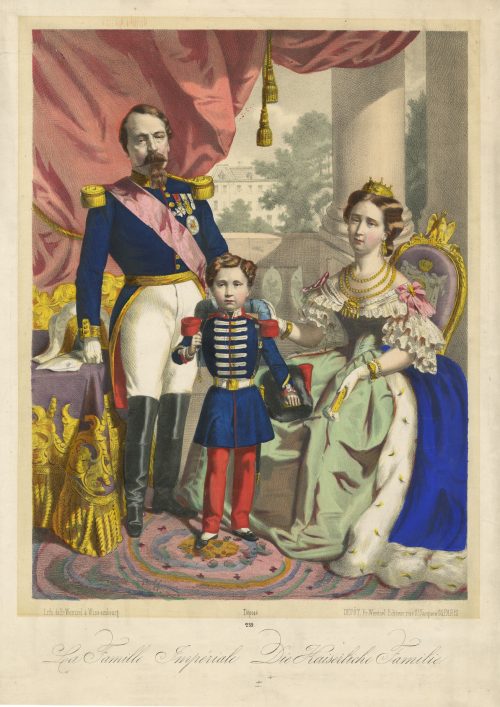 Hand-coloured lithography on wove paper, 395 x 280 mm; black ink stamp “5309” to reverse. On image: artist's initials "L. H."; on stone: "Lith. de Fr. Wentzel a Wissembourg. — Déposé — DÉPÔT, Fr. Wentzel Editeur rue St. Jacques 65, PARIS"; below centre: "239"; bottom : La famille Impériale. Die Kaizerliche Familie. Napoleon III [Charles-Louis Napoléon Bonaparte] (French, 1808 – 1873) Eugénie de Montijo [L'impératrice Eugénie] (Spanish-French, 1826 – 1920) Napoléon, Prince Imperial (Napoléon Eugène Louis Jean Joseph Bonaparte] (French, 1856 – 1879) Jean Frédéric Wentzel (French, 1807 – 1869) – publisher/printer.
Hand-coloured lithography on wove paper, 395 x 280 mm; black ink stamp “5309” to reverse. On image: artist's initials "L. H."; on stone: "Lith. de Fr. Wentzel a Wissembourg. — Déposé — DÉPÔT, Fr. Wentzel Editeur rue St. Jacques 65, PARIS"; below centre: "239"; bottom : La famille Impériale. Die Kaizerliche Familie. Napoleon III [Charles-Louis Napoléon Bonaparte] (French, 1808 – 1873) Eugénie de Montijo [L'impératrice Eugénie] (Spanish-French, 1826 – 1920) Napoléon, Prince Imperial (Napoléon Eugène Louis Jean Joseph Bonaparte] (French, 1856 – 1879) Jean Frédéric Wentzel (French, 1807 – 1869) – publisher/printer. -
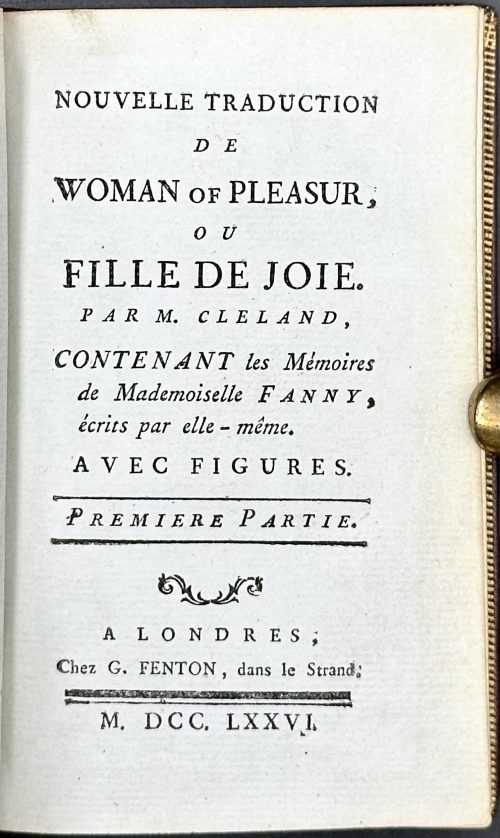 Hardcover volume, collated 18mo, 130 x 85 mm (2 parts in one). Contemporary burgundy morocco outlined with gilt triple fillet, flat spine gilt in compartments, brown morocco label gilt, all edges gilt, gilt dentelle, text printed on slightly blue laid paper with illegible watermark; dark blue endpapers, Tony Fekete (T. F.) bookplate by Wahorn to front pastedown. Frontispiece and 14 engraved plates by Elluin after Borel, with guard tissue. Graphite ms to h.t.: "Figures de Borrel. | Gravées pr. Elluin." Title-page: NOUVELLE TRADUCTION | DE | WOMAN OF PLEASUR, | OU | FILLE DE JOIE. | PAR M. CLELAND, | CONTENANT les Mémoires | de Mademoiselle FANNY, | écrits par elle – même. | AVEC FIGURES | — | PREMIERE (SECONDE) PARTIE. | — | ~ | A LONDRES; | Chez G. FENTON, dans le Strand; | — | M. DCC. LXXVI. || Collation: 18mo throughout A-O12/6, total 126 leaves plus 15 plates, incl. frontispiece. Pagination: separate for each part [1-5] 6-119 [120 blank], [1-3] 4-132, total 252 pages. Provenance: Tony Fekete (Christie’s 2014, № 54, p. 37; Price realized GBP 11,875): “[CLELAND, John (1709-1789).] Nouvelle traduction de Woman of Pleasur [sic] ou Fille de Joie. Contenant les Mémoires de Mademoiselle Fanny, écrits par elle-même. London [but Paris]: G. Fenton [Cazin], 1776. 2 volumes in one, duodecimo (128 x 80 mm). Printed on blue tinted paper. Frontispiece and 14 engraved plates on thick white paper by Elluin after Borel. (Short tear repaired in the margin of one plate, another plate with a faint dampstain touching the facing leaf of text.) Contemporary burgundy morocco, flat spine gilt in compartments, morocco label gilt, covers with a gilt triple fillet border, gilt edges, blue endpapers. THE MOST BEAUTIFUL 18TH-CENTURY ILLUSTRATED EDITION OF THIS CELEBRATED EROTIC NOVEL. An excellent copy bound in contemporary morocco. It is the second translation into French, but the first to include the exquisite plates by Elluin after Borel. These are some of the best illustrations by this remarkable partnership responsible for a number of important 18th-century libertine texts. Cohen-DeRicci 242-3; Dutel A-407 ; Gay-Lemonnyer II, 304; Pia Enfer, 915.” Catalogue raisonné: Dutel (I) A-407, p. 134; Cohen-DeRicci 242-3; Fekete (Christie's) 54, p. 37. Contributors: John Cleland (British, c. 1709 – 1789). François-Rolland Elluin (French, 1745 – c. 1822) Antoine Borel (French, 1743 – 1810) Hubert-Martin Cazin (French, 1724 – 1795) András Wahorn (Hungarian, b. 1953) Fekete, Tony Laszlo (Hungarian, b. 1972)
Hardcover volume, collated 18mo, 130 x 85 mm (2 parts in one). Contemporary burgundy morocco outlined with gilt triple fillet, flat spine gilt in compartments, brown morocco label gilt, all edges gilt, gilt dentelle, text printed on slightly blue laid paper with illegible watermark; dark blue endpapers, Tony Fekete (T. F.) bookplate by Wahorn to front pastedown. Frontispiece and 14 engraved plates by Elluin after Borel, with guard tissue. Graphite ms to h.t.: "Figures de Borrel. | Gravées pr. Elluin." Title-page: NOUVELLE TRADUCTION | DE | WOMAN OF PLEASUR, | OU | FILLE DE JOIE. | PAR M. CLELAND, | CONTENANT les Mémoires | de Mademoiselle FANNY, | écrits par elle – même. | AVEC FIGURES | — | PREMIERE (SECONDE) PARTIE. | — | ~ | A LONDRES; | Chez G. FENTON, dans le Strand; | — | M. DCC. LXXVI. || Collation: 18mo throughout A-O12/6, total 126 leaves plus 15 plates, incl. frontispiece. Pagination: separate for each part [1-5] 6-119 [120 blank], [1-3] 4-132, total 252 pages. Provenance: Tony Fekete (Christie’s 2014, № 54, p. 37; Price realized GBP 11,875): “[CLELAND, John (1709-1789).] Nouvelle traduction de Woman of Pleasur [sic] ou Fille de Joie. Contenant les Mémoires de Mademoiselle Fanny, écrits par elle-même. London [but Paris]: G. Fenton [Cazin], 1776. 2 volumes in one, duodecimo (128 x 80 mm). Printed on blue tinted paper. Frontispiece and 14 engraved plates on thick white paper by Elluin after Borel. (Short tear repaired in the margin of one plate, another plate with a faint dampstain touching the facing leaf of text.) Contemporary burgundy morocco, flat spine gilt in compartments, morocco label gilt, covers with a gilt triple fillet border, gilt edges, blue endpapers. THE MOST BEAUTIFUL 18TH-CENTURY ILLUSTRATED EDITION OF THIS CELEBRATED EROTIC NOVEL. An excellent copy bound in contemporary morocco. It is the second translation into French, but the first to include the exquisite plates by Elluin after Borel. These are some of the best illustrations by this remarkable partnership responsible for a number of important 18th-century libertine texts. Cohen-DeRicci 242-3; Dutel A-407 ; Gay-Lemonnyer II, 304; Pia Enfer, 915.” Catalogue raisonné: Dutel (I) A-407, p. 134; Cohen-DeRicci 242-3; Fekete (Christie's) 54, p. 37. Contributors: John Cleland (British, c. 1709 – 1789). François-Rolland Elluin (French, 1745 – c. 1822) Antoine Borel (French, 1743 – 1810) Hubert-Martin Cazin (French, 1724 – 1795) András Wahorn (Hungarian, b. 1953) Fekete, Tony Laszlo (Hungarian, b. 1972) -
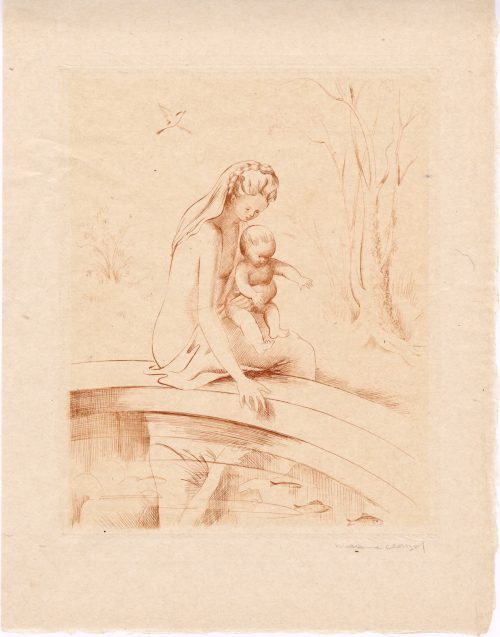 Set of 10 etchings (9 in passe-partout) printed in sanguine on the mother of pearl paper (japon nacre) from the album of 12 prints titled “Jeunesse”, presented by Gérard D'Houville (pen name of Marie de Régnier, née de Heredia) and published by La Tradition in 1945. It was a limited edition of 532 copies, some coloured on Arches paper and some as these set. Plates signed by the artist in pencil below the plate mark. The album cover is missing. Complete data for the album: JEUNESSE | 12 EAUX-FORTES ORIGINALES | DE | MARIANNE CLOUZOT | PRÉSENTÉES | PAR | GÉRARD D'HOUVILLE | {publisher’s device} | LA TRADITION | 1945 || Dimensions: mat 330 x 255 mm; window 225 x 180 mm; sheet 280 x 220 mm; plate 220 x 170 mm. Contributor: Martin van Maële [Martin, Maurice François Alfred] (French, 1863 – 1926)
Set of 10 etchings (9 in passe-partout) printed in sanguine on the mother of pearl paper (japon nacre) from the album of 12 prints titled “Jeunesse”, presented by Gérard D'Houville (pen name of Marie de Régnier, née de Heredia) and published by La Tradition in 1945. It was a limited edition of 532 copies, some coloured on Arches paper and some as these set. Plates signed by the artist in pencil below the plate mark. The album cover is missing. Complete data for the album: JEUNESSE | 12 EAUX-FORTES ORIGINALES | DE | MARIANNE CLOUZOT | PRÉSENTÉES | PAR | GÉRARD D'HOUVILLE | {publisher’s device} | LA TRADITION | 1945 || Dimensions: mat 330 x 255 mm; window 225 x 180 mm; sheet 280 x 220 mm; plate 220 x 170 mm. Contributor: Martin van Maële [Martin, Maurice François Alfred] (French, 1863 – 1926) -
 Iron tsuba of round form with design of two paper lanterns in openwork (small cut-outs, ko-sukashi ) outlined with brass wire. The plate is decorated with four concentric rows of brass dot inlay (ten-zōgan), with a brass circular wire inside the innermost row of dots (missing on the back). Hitsu-ana of rectangular form is not outlined with brass wire, which let us suppose that it was cut out at a later date. Copper sekigane. Mid Muromachi period (1454-1513). Diameter: 74.0 mm, thickness: 2.6 mm. Tsuba is illustrated at: 新版 日本刀講座 小道具鑑定編 本間 薫山 佐藤 寒山 : Shinhan Nihonto Koza, Volume VI, Kodogu Part 1. Under supervision of Honma Kunzan and Sato Kanzan. 鍔 無名 応仁 鉄地) 丸形 小透 槌目 真鍮据文 点象嵌 丸耳 : Tsuba with no signature, Ōnin style. Base metal iron (jigane), round shape, small perforations (ko-sukashi), hammering finish (tsuchime). Pre-cast brass inlay (shinchu suemon-zōgan); dot inlay (ten-zōgan); round edge (maru-mimi).
Iron tsuba of round form with design of two paper lanterns in openwork (small cut-outs, ko-sukashi ) outlined with brass wire. The plate is decorated with four concentric rows of brass dot inlay (ten-zōgan), with a brass circular wire inside the innermost row of dots (missing on the back). Hitsu-ana of rectangular form is not outlined with brass wire, which let us suppose that it was cut out at a later date. Copper sekigane. Mid Muromachi period (1454-1513). Diameter: 74.0 mm, thickness: 2.6 mm. Tsuba is illustrated at: 新版 日本刀講座 小道具鑑定編 本間 薫山 佐藤 寒山 : Shinhan Nihonto Koza, Volume VI, Kodogu Part 1. Under supervision of Honma Kunzan and Sato Kanzan. 鍔 無名 応仁 鉄地) 丸形 小透 槌目 真鍮据文 点象嵌 丸耳 : Tsuba with no signature, Ōnin style. Base metal iron (jigane), round shape, small perforations (ko-sukashi), hammering finish (tsuchime). Pre-cast brass inlay (shinchu suemon-zōgan); dot inlay (ten-zōgan); round edge (maru-mimi).
 English translation of the book indicated above Nihon Tō Kōza, Volume VI, Part 1 by Harry Afu Watson, AFU Research Enterprises, Inc., 1993. Tsuba in question illustrated on page 14 and described as follows: " Tsuba mumei Ōnin. Tetsu ji maru gata ko-sukashi tsuchime shitate shinchū suemon ten zogan maru mimi. Brass suemon". My question remains: why such a text is called 'translation' while it looks more like transliteration of romanization?
English translation of the book indicated above Nihon Tō Kōza, Volume VI, Part 1 by Harry Afu Watson, AFU Research Enterprises, Inc., 1993. Tsuba in question illustrated on page 14 and described as follows: " Tsuba mumei Ōnin. Tetsu ji maru gata ko-sukashi tsuchime shitate shinchū suemon ten zogan maru mimi. Brass suemon". My question remains: why such a text is called 'translation' while it looks more like transliteration of romanization?




